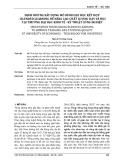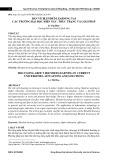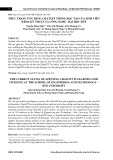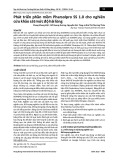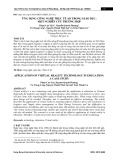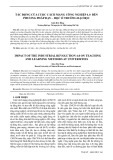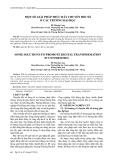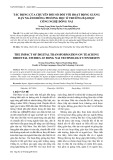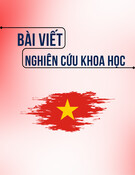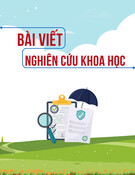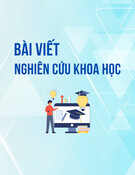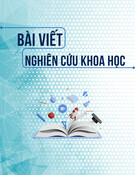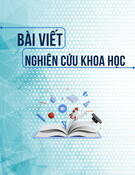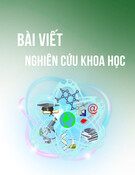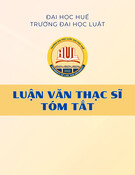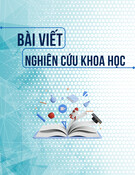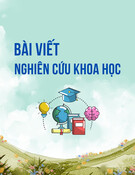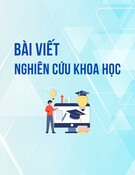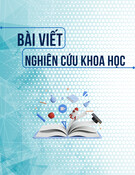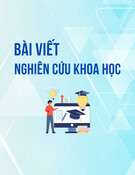
JSLHU
JOURNAL OF SCIENCE
OF LAC HONG UNIVERSITY
ISSN: 2525 - 2186
Tạp chí Khoa học Lạc Hồng, 2024, 19, 050-055
50
JSLHU, Issue 19, December 2024
ỨNG DỤNG CÔNG NGHỆ ĐỂ THU HÚT SINH VIÊN VÀO HOẠT ĐỘNG
HỌC VIẾT TẠI TRƯỜNG ĐẠI HỌC LẠC HỒNG
Võ Thị Thanh Lan, Bùi Minh Hương
Trưng Đại học Lạc Hồng, Số 10 Huỳnh Văn Nghệ, Bửu Long, Biên Hòa, Đồng Nai, Việt Nam
*Tác giả liên hệ: thanhlan@lhu.edu.vn
THÔNG TIN BÀI BÁO
TM TT
Ngày nhận: 25/8/2024
Bài viết này nghiên cứu tác động của công nghệ đến việc dạy viết cho sinh viên
chuyên ngành tiếng Anh tại Trường Đại học Lạc Hồng. Sử dụng phương pháp
nghiên cứu hỗn hợp, các nhà nghiên cứu đã khảo sát 120 sinh viên và 6 giảng viên,
phân tích hiệu quả của các công cụ và chiến lược sử dụng công cụ công nghệ khác
nhau trong việc cải thiện sự tham gia của sinh viên trong bốn lớp học môn viết,
cũng như thái độ của cả sinh viên và giảng viên đối với việc tích hợp công nghệ
vào việc hướng dẫn học viết. Kết quả nghiên cứu cho thấy rằng việc khai thác các
công cụ công nghệ để dạy viết có thể gia tăng sự tham gia của sinh viên. Tuy nhiên,
thái độ đối với việc tích hợp công nghệ có sự khác biệt giữa sinh viên và giảng
viên, cùng với một số quan điểm bày tỏ thắc mắc về tác động của các công cụ đối
với các phương pháp giảng dạy thông thường. Các phát hiện cho thấy rằng công
nghệ có thể là một công cụ hiệu quả để hỗ trợ việc giảng dạy kĩ năng viết, nhưng
việc triển khai áp dụng cần được giải quyết một cách thận trọng dựa trên thái độ và
nhu cầu của cả sinh viên và giảng viên.
Ngày chỉnh sửa: 29/9/2024
Ngày chấp nhận: 29/10/2024
Ngày đăng: 8/12/2024
T KHA
Kỹ năng viết;
Công cụ số;
Tích hợp.
INCORPORATING TECHNOLOGY TO ENHANCE STUDENTS’
ENGAGEMENT IN WRITING CLASSES AT LAC HONG UNIVERSITY
Vo Thi Thanh Lan, Bui Minh Huong
Lac Hong University, No. 10 Huynh Van Nghe Str., Buu Long Ward, Bien Hoa, Dong Nai, Vietnam
*Corresponding Author: thanhlan@lhu.edu.vn
ARTICLE INFO
ABSTRACT
Received: Aug 25th, 2024
This research paper investigates the impact of technology on writing instruction for
English majors at Lac Hong University. Using a mixed-methods approach, the
researchers surveyed 120 students and six instructors and analyzed the
effectiveness of various technological tools and strategies in improving students’
participation in four writing classes, as well as the attitudes of both students and
instructors towards technology integration into writing instructions. The research
findings reveal that exploiting technological tools for the teaching of writing can
give rise to improved participation among students. However, attitudes towards
technology integration differ amongst students and instructors, with some
expressing wonders about its impact on conventional teaching methods. The
findings suggest that technology can be a proficient device to support writing
instruction, but its implementation should be deliberately tackled in light of the
attitudes and needs of both students and instructors.
Revised: Sep 29th, 2024
Accepted: Oct 29th, 2024
Published: Dec 8th, 2024
KEYWORDS
Writing skills;
Technological tools;
Integration.
Available online at: https://js.lhu.edu.vn/index.php/lachong.





